

Sir Edward Grey is connected to many things that will eventually get Hell Notes articles of their own some day (including a particular secret society), but for now let’s just focus on him. This Wednesday Witchfinder will be kicking into an all-new phase with Kim Newman and Maura McHugh writing a miniseries drawn by Tyler Crook, The Mysteries of Unland. You may consider this a primer for Witchfinder if you’ve never read it before, although The Mysteries of Unland will be very new reader friendly and you should be able to pick up without any prior knowledge. That said, if you are worried about spoilers, this column will spoil large chunks of Hellboy up to and including Hellboy in Hell #4 and all previous Witchfinder stories, all of which have been out for quite some time now, plus a little bit of the recent B.P.R.D. Hell on Earth stories, but nothing too big.


When the corpse was examined later, they found raw meat his stomach and a locket that had belonged to one of the missing children. As for Edward, his wounds should have claimed him, but Lord Hastings wouldn’t allow it. He gave Edward a bed in his own home, and the boy spent the rest of the Summer under the cares of doctors, nurses, and a priest that made sure he did not inherit the werewolf curse. Afterwards Lord Hastings looked after Edward like his own son and saw that he got an education.

On the 6th of February, 1979, Edward thwarted an attempt on Queen Victoria’s life by three witches.1 This led to Edward becoming a Knight of the Realm at age of twenty-two.

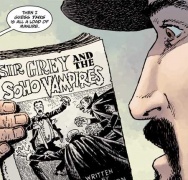
Along with being knighted, 1979 was the year of a particular case with repercussions that would stay with Sir Edward for the rest of his life. There had been a series of murders, all targeting members of the Saunders Expedition. The expedition had found an ancient city in the desert which they believed to be from the Later Hyperborean Empire.2 Most of it was underground, ruins of a civilisation previously unknown, along with younger artefacts, much more primitive, evidence of the earliest humans that had lived in the ruins long after the original builders had gone.

Sir Edward attempted to stop the creature, grabbing a sword artefact the Saunders Expedition had brought back with them. The sword seemed to have some power over the creature, and it fled before it.

B.P.R.D. readers will know this sword. It’s a Hyperborean weapon used by their priests. We encountered one like it in B.P.R.D.: Hollow Earth, and then later Agent Howards came by the very sword Sir Edward was using here in B.P.R.D. Hell on Earth: The Abyss of Time. In that story, we also learned a little about the sword’s history, how it had been found broken by a prehistoric man in Hyperborean ruins. He had made a makeshift handle for it, and with it had wielded incredible power. He passed it on to his son, and when he died it was passed on to his son, Gall Dennar, whose spirit would intermingle across time with Agent Howards in the modern era.

So my point is, the sword that Sir Edward grabbed was kind of a big deal.
Now, let’s get back to Sir Edward and the latest victim of the mysterious creature. An examination of the corpse by doctors was not able to determine the cause of death. It was as though all the fluids had been extracted from the body, but there were no puncture marks. With nothing else to go on, Sir Edward set out to find Donald Blackwood, only to find he too had been murdered, though not like the others. He was torn apart, blood everywhere, and there was no way for Sir Edward to ask a dead man where the lost skeleton was.

Together, Miss Wolf and Zora summoned the spirit of Donald Blackwood, but while they waited for him to arrive, Zora saw something in Sir Edward that troubled her. She told him he was a man that laboured in the service of angels, but that he should remember the fate of so many in that service. She saw a phantom walking behind Sir Edward, a hood covering its face, but with words written in fire ablaze upon its forehead: “Acheron.”
Continued below
In Greek mythology, Acheron, the river of woe, was one of four rivers that converged on the Styx which formed the boundary between Earth and Hell. Acheron was the river crossed by the ferryman, Charon, with the newly dead.


With the creature’s bones and Miss Wolf as a guide, Sir Edward came to “The Church of the Inner World,” with its entire congregation dead. The only one left alive was Reverend Blum,3 who confessed the creature had come to him two nights ago, and his congregation had given blood to strengthen it. They thought the creature was an angel sent from the inner world of Shambhalla.4
When the creature drank too deeply of the Reverend’s blood, he had a vision that revealed its true nature. Those last Hyperboreans had built ancient war machines far under the earth so that they might rise up and conquer the world. In vats they had grown slaves to tend their machines, but the slaves rebelled against their masters, and slaughtered them all. The “angel” had been one of those slaves, and long ago, it had made its way to the surface, into the ruins of an ancient Hyperborean city where it was found by the early humans making camp there, and murdered. (These early humans would probably have been Gall Dennar’s tribe, considering his weapon was found at the same site.)


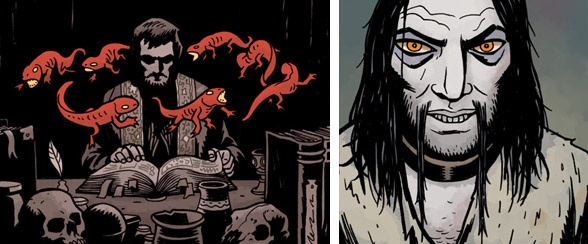
This gambit ultimately paid off for Sir Edward, and with the creature bound to its bones, it could be killed with mere bullets, but in the chaos that followed, the Heliopic Brotherhood arrived, taking the corpse and the sword, murdering Sir Edward’s companions and Miss Wolf. Before passing on, Miss Wolf appeared to Sir Edward and warned him not to pursue the matter, that it would lead to his ruin. She pleaded with him to return to his home in Sussex.

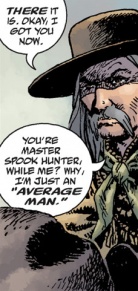
That Kaler had knowledge of black magic and yet was still a good man was something that Sir Edward had trouble reconciling. And he had to confront his own hypocrisy, for his own knowledge of the supernatural had not tainted him. Furthermore, he was forced to acknowledge that there was power for good in magic that clearly had no connection to his Christian faith, and that there were parallels between the tribal magic of the Paiute people and the Christian exorcisms that had been performed on him as a child while he was cleansed of the werewolf curse.

With Kaler and Isaac’s help, Sir Edward Grey tracked down Lord Glaren (who was a “zonbi” by then) and undid the magic that Eris had been working, weaving souls into a shawl from which she could draw power. During their confrontation, Eris had killed Sir Edward, which had allowed him in turn to kill the spirit of a Paiute native that had been used to bind the shawl together. Sir Edward had no explanation of how he had survived his encounter with Eris, though he suspected it had something to do with a bracelet Isaac had given him. Sir Edward continued to wear the bracelet, and when he returned to London his colleagues noticed he grown more inquisitive about matters of a spiritual nature.

Which brings us to 1881, the year in which The Mysteries of Unland is set. However, since the story doesn’t come out until Wednesday, there’s nothing I can say about it.
Even though we’re now caught up with all the Witchfinder stories to date, there’s still a little more yet to discuss. As I said at the beginning of the article, Sir Edward Grey is connected to a lot of different elements in the Hellboy Universe, and his history has been discussed in other stories. From that, it’s possible to cobble together a timeline of his career.

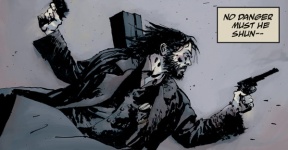
In 1888, Sir Edward was involved in the Jack the Ripper killings investigation. Little is known about the matter except that Sir Edward left Her Majesty’s service in February 1889 after the decision to suppress the Ripper’s true identity, ending his ten-year career as a government agent. Sir Edward established himself as a private occult detective operating out of rooms above a tavern in Whitechapel afterwards. By this point both his father and Lord Hastings had died, and he had inherited a considerable sum of money, though he continued to live in relative poverty.
Continued belowOn Hellboy’s first visit to London as a child, he visited an old pub in Whitechapel where he was told Sir Edward Grey and his companions used to frequent in the 1890s. These companions were all members of the Silver Lantern Club, as was Sir Edward Grey.

Sir Edward never stopped investigating the Heliopic Brotherhood of Ra and became increasingly convinced that they posed a serious threat to the world. In 1893 London’s Universal Temple of the Heliopic Brotherhood of Ra closed due largely to Sir Edward. By 1908, most of the members had left England, so Sir Edward closed his practice and set about hunting them across Europe and America. For six years no one knew where Sir Edward was until he re-emerged in New York on April 13, 1914 and established a new detective practice.
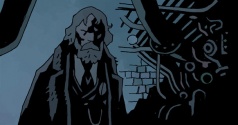


What happened to Sir Edward during his time in the Abyss is unknown, but when he appeared on Earth again he was unrecognisable as his former self. The cloaked and masked Sir Edward has appeared several times throughout the Hellboy series, usually in very strange company for a man that once thought all magic was an evil.
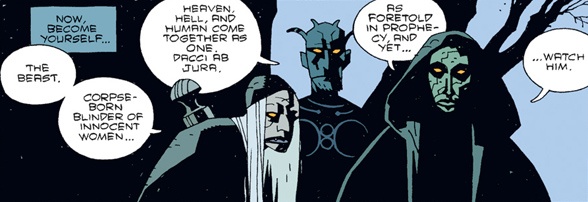
In Hellboy: Wake the Devil Sir Edward made his first modern day appearance, watching Hellboy from the etherworld. I’ve referred to this “etherworld” in passing in previous Hell Notes, but never really explained what it is. However, since Sir Edward spent so much time there, I guess I should attempt some semblance of an explanation. This is going to get really vague. So, this place is never really named in the comics, except perhaps for a rather cryptic “elsewhere.” I call it the etherworld, because I feel like this world belongs to the ether, the space in between (in this case, the space in between worlds). While it is a physical space, I don’t think it’s a literal one, and certain aspects of its appearance are meant to by symbolic. The Baba Yaga has appeared there after she faded from the world, so it is certainly not an Earthly location. Basically, make of this place what you will, and call it what you like. It’s very much open to interpretation. But at least now you know what I’m talking about… or perhaps you’re even more confused. Sorry about that.
Right, so let’s get back to Ed Grey watching Hellboy. In the company of the Baba Yaga and Dagda, the High King of the Tuatha Dé Danann, he witnessed one of Hellboy’s most transformative moments, when he broke from the destiny that had been made for him and began to forge his own. The Sir Edward in this story clearly had far more experience than when he was first dragged down into Hell. He spoke of prophecy with great authority in the presence of beings with foresight of their own, and they listened to him.
Continued belowSir Edward appeared again in Hellboy: Box Full of Evil, once again watching Hellboy, this time in the company of King Dagda and his goblin servant. Here, he spoke to Hellboy, and Hellboy heard his voice as he counselled him. It was from these three that Hellboy learnt of the secret name he bore, Anung Un Rama, and what it truly meant.


In the closing moments of Hellboy: The Island, Sir Edward Grey again appeared as a watchful figure, this time alongside the witch doctor Mohlomi. Yet again Edward demonstrated an uncanny knowledge of the shape the future was taking. Mohlomi also mentioned that he was ready to go, implying he was ready to die. Given Sir Edward’s appearance, much like the Reaper, many fans once had theories that he was the ferryman that escorted the dead to the next life. And perhaps this is at least partially true, especially given his connection with the river Acheron and its own links to the ferryman.
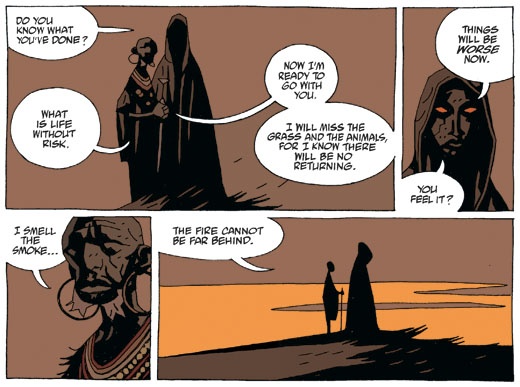
The next time Sir Edward appeared was in the second epilogue of Hellboy: Darkness Calls, when he visited the tomb of the goddess Hecate. The goddess referred to herself there as Sir Edward’s queen, though he denied this was ever the case. But Hecate was the Queen of Witches, and the hooded Grey had become a practitioner of witchcraft. It seems to me she was mocking his irony, a witchfinder that found himself to be a witch. From Hecate, Sir Edward learnt her true history, and her involvement in the fall of Hyperborea. I wonder if this is the first tomb Sir Edward had visited and spoken with the dead. He had become very wise by this point. Perhaps this was one way in which he gained this wisdom.
Before Sir Edward’s departure, Hecate spoke of the future to him:


In the final pages of Hellboy: The Wild Hunt, Hellboy took up the sword Excalibur, and from the etherworlds he was watched by various figures, including Sir Edward and Mohlomi. I smile at the thought of the witchfinder in the company of a witch doctor. That these two were still together here makes me wonder if perhaps we might see Mohlomi again some day. After all, Mohlomi interfered when Hellboy was going to die in The Island, so perhaps the old witch doctor also took his place in the afterlife that day. I don’t imagine he’d end up in Hell, but maybe he stayed in the Abyss, the outer edge of Hell. Either way, I have a feeling Sir Edward would have had conversations with Mohlomi to gain wisdom as he had with Hecate.
Which brings us to Hellboy’s death.
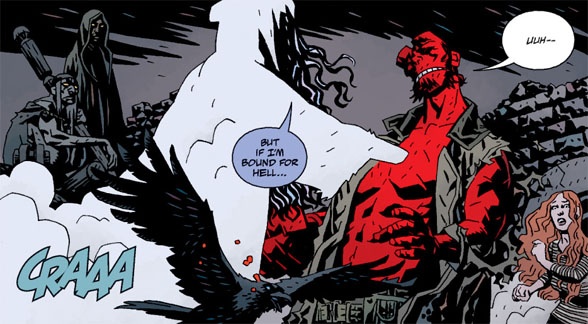
And afterwards, the Baba Yaga and Sir Edward had a chat.


Sir Edward came to Hellboy’s aid, keeping monsters and a vengeful enemy from him, the war engine, Eligos.8 Eligos warned him that if he sided with his enemy he would likewise be destroyed, but his threat didn’t even make Sir Edward pause. That die had already been cast. During the conflict, Hellboy was separated from Sir Edward and become lost, drifting in the Abyss. Yet again Sir Edward saved him, but he was warned that doing it again would not be possible. Unknown to Hellboy, there was a cost for this rescue. Even in death, there are still things Hellboy has yet to do. The first of these tasks has fallen to Sir Edward now, though what this task is, I cannot guess, but whatever it is, he will be damned for it.
Once Hellboy was safe, he and Sir Edward had a little chat in Sir Edward’s home, the Castle of the Warlock Angus Weir. Upon recognising a painting on the wall9 from his visit to Whitechapel as a child, Hellboy realised he was in the company of the famed occult investigator. Sir Edward told Hellboy that he had been watching him for a very long time, and that he knew what he had seen in Hell and the things he had done, that he had gone down into the vaults under Pandemonium and murdered Lucifer. Hellboy had no memory of the murder though. On this matter, Sir Edward had this to say…

I wonder what memories Sir Edward has left locked, boarded up, and bricked over. I hope in a comic some day we shall meet this wise woman he spoke of.
Before parting company, Sir Edward pointed out to Hellboy that though he lost his whole world, for the first time he was truly free. Even though he still carried the Right Hand of Doom, there was no one left in Hell that wanted it. Hellboy had a chance to begin again. Though after Hellboy left, the ghost of Angus Weir appeared, and accused Grey of lying to Hellboy. While it was true that no one wanted the Hand, he certainly wasn’t free. There are still things Hellboy is bound to do.

And that’s it. That’s what we know about Sir Edward Grey so far. It’s significantly less than what we don’t know. To me it feels like there’s so much to explore. Of course, there are the stories of Sir Edward Grey, the witchfinder and agent of the Queen from 1879 to 1889. I’d like to think that the Witchfinder series will eventually cover the encounter with Jack the Ripper in 1888, and Sir Edward’s run-in with Vladimir Giurescu in 1882. Considering the upcoming miniseries is set in 1881, the Giurescu story may even be the miniseries to follow it.
But there’s more to Sir Edward than his time in the service of the Queen. I would certainly enjoy the tales of the Silver Lantern Club and Sir Edward’s hunting of the Heliopic Brotherhood of Ra. A story about his involvement in the 1893 closing of London’s Universal Temple would certainly be very interesting. As would his time in New York from 1914 to 1916. I’d even like to see him meet up with Isaac again, who I’d assume would not have aged a day, though he would perhaps have garnered a few more scars.

But for now, Witchfinder: The Mysteries of Unland will be coming out next week, written by Kim Newman, the author of the Anno Dracula series of novels, and Maura McHugh, the writer of the comic Jennifer Wilde and passionate Hellboy fan. Tyler Crook is handling the art duties, and he and colourist Dave Stewart are doing something really different with this one. It really is a beautiful story to look at. So pick it up! It’s going to be good…

1The Witches of Farnham: Sara Webb, and Mary and Elizabeth Washbrook. The Washbrook witches were the great-aunts of George Washbrook, who became the last King of Britain after Hellboy abdicated in Hellboy: The Storm and the Fury.
2Urrasan or Hypos, two of the seven cities established by the Later Hyperborean Empire (another being Atlantis).
3Reverend Blum wrote My Time Among the Spirits: Revelations by the Reverend T.S. Blum, published 1869. It detailed visions shown to him of Shambhalla.
4Shambhalla, considered to be a new Garden of Eden where the last survivors of Hyperborea lived in the Inner World.
5Lord Adam Glaren was a member of the Heliopic Brotherhood of Ra and for years he kept the mummy Panya prisoner in his household until she escaped from him with the help of the Oannes Society.
6Reidlynne would later become the Carmelo, the site of Project Enkelados in the 1940s. The local local tavern there was called Kaler’s. See B.P.R.D.: 1948 for further details.
7Gruagach the Changeling, was a fairy that became trapped in the shrunken body of Grom the War Pig after his encounter with Hellboy in The Corpse. He never really got over that.
8Eligos first appeared in Hellboy: The Wild Hunt #5. He lost everything after Hellboy defeated him.
9“Death Riding an Elephant” by Walter Heap, better remembered not as a painter, but the author of The Incredible Adventures of a Small Mechanical Head (1899), The Mechanical Head Returns (1900), and The Mechanical Head Returns Again (1902).






